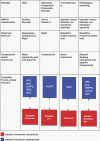Probing compulsive and impulsive behaviors, from animal models to endophenotypes: a narrative review
- PMID: 19940844
- PMCID: PMC3055606
- DOI: 10.1038/npp.2009.185
Probing compulsive and impulsive behaviors, from animal models to endophenotypes: a narrative review
Abstract
Failures in cortical control of fronto-striatal neural circuits may underpin impulsive and compulsive acts. In this narrative review, we explore these behaviors from the perspective of neural processes and consider how these behaviors and neural processes contribute to mental disorders such as obsessive-compulsive disorder (OCD), obsessive-compulsive personality disorder, and impulse-control disorders such as trichotillomania and pathological gambling. We present findings from a broad range of data, comprising translational and human endophenotypes research and clinical treatment trials, focussing on the parallel, functionally segregated, cortico-striatal neural projections, from orbitofrontal cortex (OFC) to medial striatum (caudate nucleus), proposed to drive compulsive activity, and from the anterior cingulate/ventromedial prefrontal cortex to the ventral striatum (nucleus accumbens shell), proposed to drive impulsive activity, and the interaction between them. We suggest that impulsivity and compulsivity each seem to be multidimensional. Impulsive or compulsive behaviors are mediated by overlapping as well as distinct neural substrates. Trichotillomania may stand apart as a disorder of motor-impulse control, whereas pathological gambling involves abnormal ventral reward circuitry that identifies it more closely with substance addiction. OCD shows motor impulsivity and compulsivity, probably mediated through disruption of OFC-caudate circuitry, as well as other frontal, cingulate, and parietal connections. Serotonin and dopamine interact across these circuits to modulate aspects of both impulsive and compulsive responding and as yet unidentified brain-based systems may also have important functions. Targeted application of neurocognitive tasks, receptor-specific neurochemical probes, and brain systems neuroimaging techniques have potential for future research in this field.
Figures

Similar articles
-
Compulsivity in obsessive-compulsive disorder and addictions.Eur Neuropsychopharmacol. 2016 May;26(5):856-68. doi: 10.1016/j.euroneuro.2015.12.003. Epub 2015 Dec 11. Eur Neuropsychopharmacol. 2016. PMID: 26774279 Review.
-
Translatable and Back-Translatable Measurement of Impulsivity and Compulsivity: Convergent and Divergent Processes.Curr Top Behav Neurosci. 2016;28:53-91. doi: 10.1007/7854_2015_5013. Curr Top Behav Neurosci. 2016. PMID: 27418067 Review.
-
Compulsive and impulsive symptomatology in trichotillomania.Psychopathology. 1995;28(4):208-13. doi: 10.1159/000284923. Psychopathology. 1995. PMID: 7480576
-
Are obsessive-compulsive symptoms impulsive, compulsive or both?Compr Psychiatry. 2016 Jul;68:111-8. doi: 10.1016/j.comppsych.2016.04.010. Epub 2016 Apr 15. Compr Psychiatry. 2016. PMID: 27234191 Free PMC article.
-
Compulsive aspects of impulse-control disorders.Psychiatr Clin North Am. 2006 Jun;29(2):539-51, x. doi: 10.1016/j.psc.2006.02.002. Psychiatr Clin North Am. 2006. PMID: 16650722 Free PMC article. Review.
Cited by
-
A Systematic Review of Obesity and Binge Eating Associated Impairment of the Cognitive Inhibition System.Front Nutr. 2021 Apr 29;8:609012. doi: 10.3389/fnut.2021.609012. eCollection 2021. Front Nutr. 2021. PMID: 33996871 Free PMC article.
-
Chronic HIV-1 Tat exposure alters anterior cingulate cortico-basal ganglia-thalamocortical synaptic circuitry, associated behavioral control, and immune regulation in male mice.Brain Behav Immun Health. 2020 May;5:100077. doi: 10.1016/j.bbih.2020.100077. Epub 2020 Apr 29. Brain Behav Immun Health. 2020. PMID: 33083793 Free PMC article.
-
An Avoidance-Based Rodent Model of Exposure With Response Prevention Therapy for Obsessive-Compulsive Disorder.Biol Psychiatry. 2016 Oct 1;80(7):534-40. doi: 10.1016/j.biopsych.2016.02.012. Epub 2016 Feb 17. Biol Psychiatry. 2016. PMID: 27086546 Free PMC article.
-
Effects of amphetamine, methylphenidate, atomoxetine, and morphine in rats responding under an adjusting stop signal reaction time task.Psychopharmacology (Berl). 2019 Jun;236(6):1959-1972. doi: 10.1007/s00213-019-5183-x. Epub 2019 Feb 23. Psychopharmacology (Berl). 2019. PMID: 30798404
-
A Working Hypothesis for the Role of the Cerebellum in Impulsivity and Compulsivity.Front Behav Neurosci. 2019 May 7;13:99. doi: 10.3389/fnbeh.2019.00099. eCollection 2019. Front Behav Neurosci. 2019. PMID: 31133834 Free PMC article.
References
-
- Aron AR, Dowson JH, Sahakian BJ, Robbins TW. Methylphenidate improves response inhibition in adults with attention-deficit/hyperactivity disorder. Biol Psychiatry. 2003;54:1465–1468. - PubMed
-
- Aron AR, Poldrack RA. The cognitive neuroscience of response inhibition: relevance for genetic research in attention-deficit/hyperactivity disorder. Biol Psychiatry. 2005;57:1285–1292. - PubMed
-
- Baxter LR, Jr, Phelps ME, Mazziotta JC, Guze BH, Schwartz JM, Selin CE. Local cerebral glucose metabolic rates in obsessive-compulsive disorder. A comparison with rates in unipolar depression and in normal controls. Arch Gen Psychiatry. 1987;44:211–218. - PubMed
-
- Bechara A. Risky business: emotion, decision-making, and addiction. J Gambl Stud. 2003;19:23–51. - PubMed
Publication types
MeSH terms
Grants and funding
- P50 AA015632/AA/NIAAA NIH HHS/United States
- DA11779/DA/NIDA NIH HHS/United States
- R01 DA015757/DA/NIDA NIH HHS/United States
- 076274/Z/04/Z/WT_/Wellcome Trust/United Kingdom
- R01 DA020709/DA/NIDA NIH HHS/United States
- R01 DA011779/DA/NIDA NIH HHS/United States
- P50 DA09241/DA/NIDA NIH HHS/United States
- P50 AA012870/AA/NIAAA NIH HHS/United States
- R37 DA015969/DA/NIDA NIH HHS/United States
- DA019039/DA/NIDA NIH HHS/United States
- RL1 AA017539/AA/NIAAA NIH HHS/United States
- DA12487/DA/NIDA NIH HHS/United States
- P50 DA009241/DA/NIDA NIH HHS/United States
- AA12870/AA/NIAAA NIH HHS/United States
- DA1670/DA/NIDA NIH HHS/United States
- R01 DA020908/DA/NIDA NIH HHS/United States
- DA020709/DA/NIDA NIH HHS/United States
- R01 DA019039/DA/NIDA NIH HHS/United States
- DA015757/DA/NIDA NIH HHS/United States
- R37 DA15969/DA/NIDA NIH HHS/United States
- RL1AA017539/AA/NIAAA NIH HHS/United States
- DA020908/DA/NIDA NIH HHS/United States
- R01 DA023051/DA/NIDA NIH HHS/United States
- G001354/WT_/Wellcome Trust/United Kingdom
- AA015632/AA/NIAAA NIH HHS/United States
- P01 NS019632/NS/NINDS NIH HHS/United States
LinkOut - more resources
Full Text Sources
Other Literature Sources
Medical

